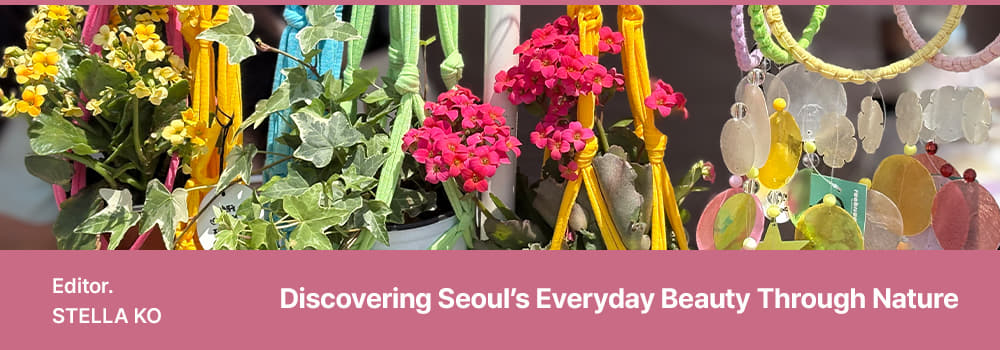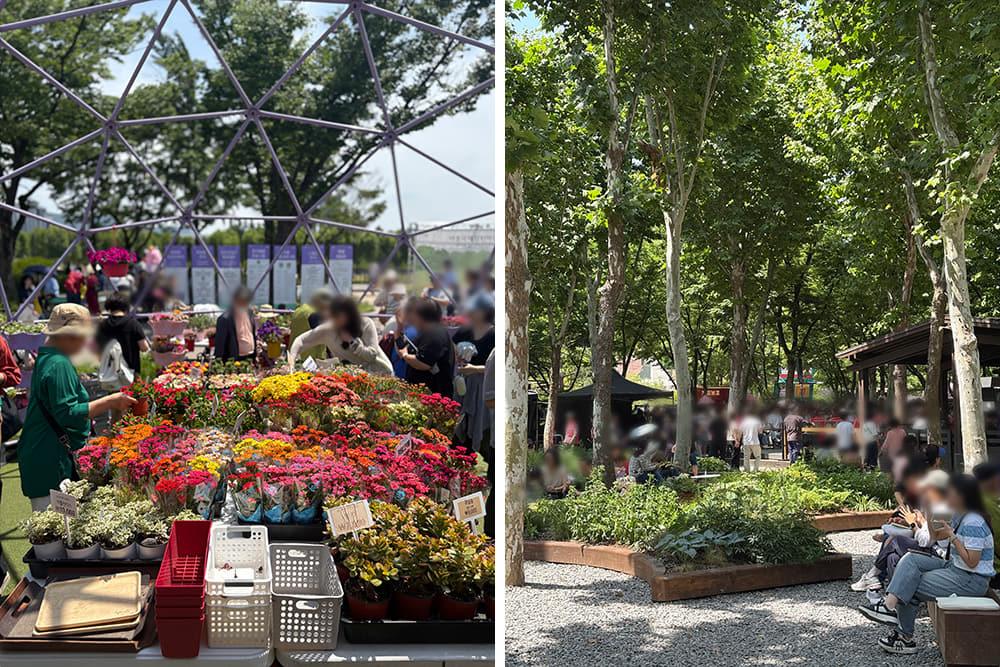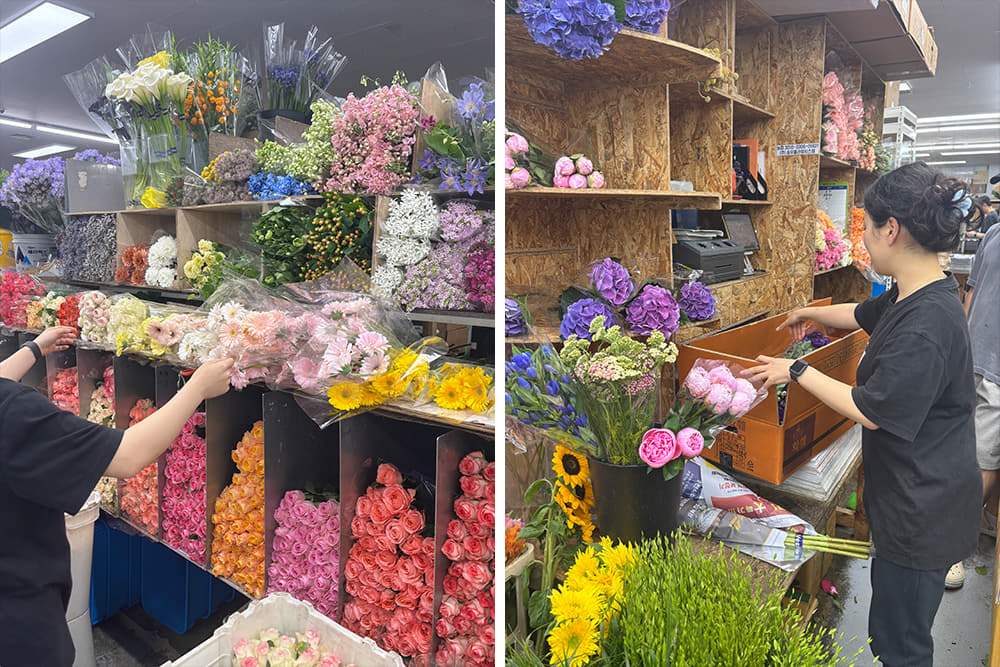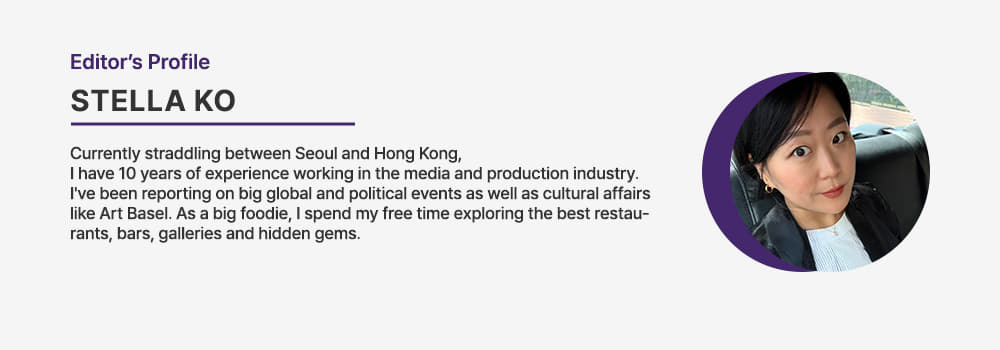
Just when you think you know the city, Seoul offers something unexpected. I didn’t think I would spend a whole day surrounded by greenery and flowers, but that’s exactly what happened – and it was one of the most refreshing days I’ve had in a while.
This month, I set out to explore how nature weaves into everyday life here — not through big hikes or countryside getaways, but through small, beautiful moments right in the city. From wandering through a garden show in the middle of Seoul to exploring a flower market buzzing with locals and a serene tea ceremony, these three stops offer a beautiful way to reconnect with nature.
■ Seoul International Garden Show 2025
Held from May 22 to October 20, the Seoul International Garden Show is the city’s largest and longest-running edition yet. And it has transformed Boramae Park into a 400,000-square-meter urban garden featuring 111 show gardens.

According to the Seoul Metropolitan Government, the show is part of the “Garden City Seoul” initiative, a long-term vision to integrate more green spaces into the urban fabric and promote sustainable, community-centered living.
I visited during the weekend, and the park was buzzing with life. Families and friends were sprawled out on picnic blankets and tents or gathered under shaded seating areas to relax. A row of food trucks served up everything from pizza and kebabs to churros and ice cream, making it easy to spend an entire afternoon immersed in nature.
The surrounding area, free from high-rise buildings, gave the whole park a forest-like atmosphere. And beyond the gardens, a bustling marketplace offered everything from potted plants to gardening tools.

The layout was easy to navigate thanks to the green and purple directional signs, and visitors could pick up a map or join an English docent tour at the information booth — though I found that simply wandering and getting lost among the gardens was just as rewarding.
If the Seoul International Garden Show is a curated celebration of floral artistry, then Yangjae Flower Market is where that beauty becomes part of everyday life. For someone like me who used to travel a lot for work and lived out of hotels for months, one of the tricks I used to bring in vibrancy was to go pick out fresh flowers in a local market. Even a simple bouquet in your room can make a huge difference.
Tucked beneath an overpass in southern Seoul, this sprawling wholesale and retail market is where florists, hobbyists, and flower lovers come to source blooms by the bundle. The scent of fresh petals mixed with loud chatter felt both chaotic and poetic.

To help navigate the market, I spoke with local florist Juwon Jeon, founder of Goalflora, who shared her tips for first-time visitors:
● When to Go: “Visit during the cooler seasons,” she recommends. “And if you’re going in summer, aim for mid-morning on Tuesdays, Thursdays, or Saturdays—between 10 AM and noon. That’s when the market is less crowded with industry buyers, and vendors tend to be more relaxed and friendly.”
● What to Buy Now: For summer, she suggests bold-colored roses, sedum, and clematis as standout choices. “They’re vibrant and long-lasting, perfect for the heat.”
● How to Choose Fresh Flowers: “Always ask how recently the flowers were delivered,” she advises. “And don’t just look at the petals, check the stems and leaves. They should be a healthy, vibrant green.”
● Budget-Friendly Picks: While she notes that “cheap and luxurious don’t often go together,” she does recommend imported flowers like calla lilies and sandersonia for a refined look without breaking the bank.
● Beginner-Friendly Blooms: For those new to flower arranging, she suggests starting with bold, structured flowers like roses, lisianthus, or tulips. “They’re easier to handle and arrange than delicate filler flowers.”
● Caring for Your Flowers: Her golden rule? “Change the water daily. Don’t add anything strange — just clean water is enough to keep them fresh for over a week.”
From visual and tactile experiences, I decided to go on a sensory and meditative journey. The tea ceremony at Heesum offers a quiet, reflective way to experience nature. Korean Darye (tea ceremony) differs from Chinese and Japanese tea traditions, emphasising politeness, balance, and curved, flowing movements inspired by traditional Korean choreography.

At Heesum, founded 11 years ago by certified tea master Songna S. Sim, tea is not just a beverage — it’s a way of bringing nature into the body. As Songna explains, “tea is simply water and leaves, but these two elements hold the essence of mountains, wind, soil, and sun.” Each sip becomes a meditation on slowness, rootedness, and presence.
I attended a 90-minute hands-on workshop but Heesum also offers a 12-week intensive program, as well as sessions in singing bowls and calligraphy. It was a multisensory experience. Every movement, from folding a cloth to pouring water, was deliberate and graceful. The ceremony began with a greeting called “Gongsu”, and we used museum-grade teaware inspired by summer fruits and ginkgo seeds. The tea master’s movements were controlled and purposeful that simply observing her felt like a practice in itself.

We tasted three teas, each with its own story and pairing: Hadong black tea that had subtle yet powerful flavors, fresh green tea harvested in early May, and magnolia flower tea with a surprisingly gingery kick. It was hard to pick a favorite as they were all so distinct and the flavors deepened as the tea cooled.
As Songna shared, “each sip reminds us of what is slow, rooted, and alive,” a reminder that nature, when invited into our daily lives, can be both grounding and transformative.
Whether it’s through a garden stroll, a handful of fresh flowers, or a quiet cup of tea, I was reminded that nature doesn’t have to be far away — it can be part of our everyday life, if we let it.
